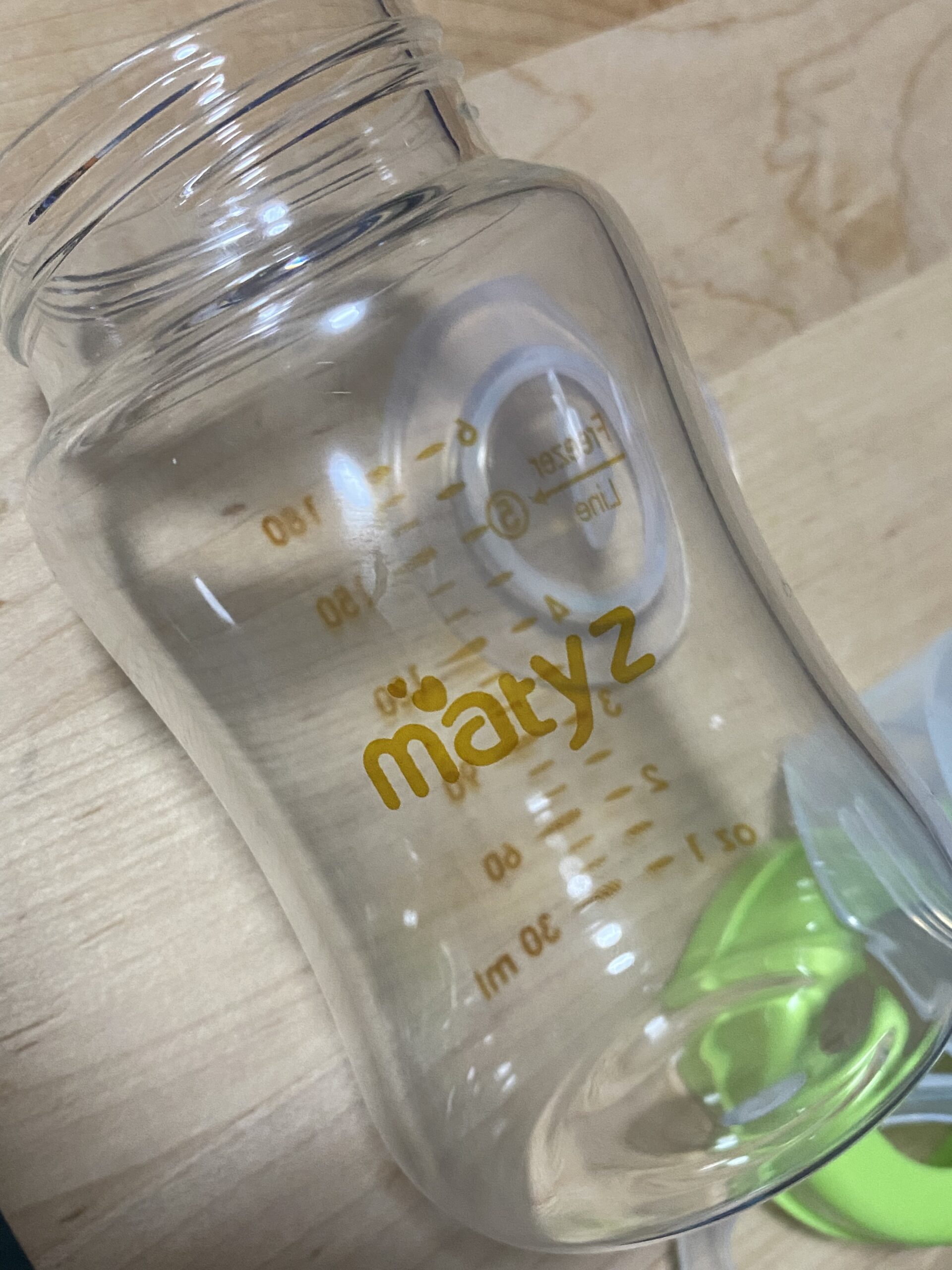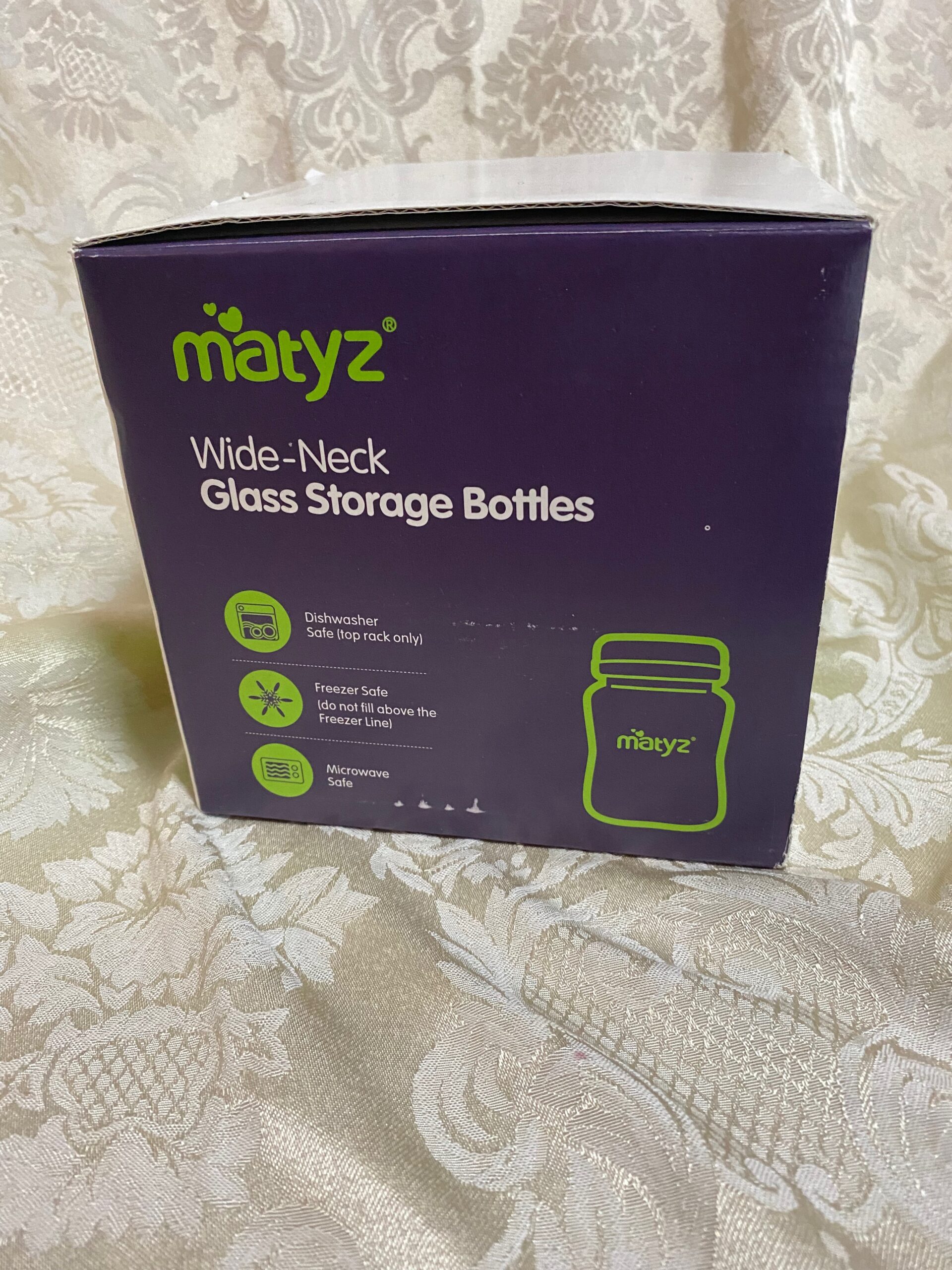XRF test results for matyz brand wide neck glass breast milk storage bottle
Published: October 1, 2022
Quick Summary: Trace Cadmium and Antimony were found in the unpainted glass of this product (see “Reading #1” below). The elements of the bottle that tested positive for trace Cadmium and Antimony were the thicker glass edges of the bottle – as we always try to do a reading on the thickest part of an unpainted glass object when we test it, to get the most accurate (least diluted) reading.
The side wall of this glass bottle (where the painted logo is (“Reading #2” below) did not test positive for trace Cadmium or Antimony, but that is likely due to the fact that the readings for those metals were diminished due to the fact that the glass in that part of the bottle is much thinner than the areas tested in “Reading #1”. That said, the levels of Cadmium and Antimony found in the glass of this bottle are considered by all (U.S. and International) regulatory standards to be within safe range and not of any concern. Given the levels of the two toxic heavy metals found in this product are so incredibly low, it is very unlikely that trace amounts of Cadmium and Antimony (at the specific levels found) would result in any contamination of the contents (breast milk) with long-term storage.
Full XRF test results for the glass breast milk bottle storage system pictured are below.
Reading #1) Plain (unpainted) glass of bottle
60-second reading (all readings repeated multiple times to confirm results)
Results below that are noted in RED are toxic metals, but present at levels are safe by all current / modern standards
- Lead (Pb): non-detect
- Cadmium (Cd): 24 +/- 5 ppm
- Tin (Sn): 15 +/- 8 ppm
- Mercury (Hg): non-detect
- Selenium (Se): non-detect
- Barium (Ba): non-detect
- Chromium (Cr): non-detect
- Antimony (Sb): 25 +/- 11 ppm
- Copper (Cu): 38 +/- 23 ppm
- Zirconium (Zr): 911 +/- 23 ppm
- Niobium (Nb): 608 +/- 21 ppm
- Indium (In): 20 +/- 7 ppm
- Iron (Fe): 209 +/- 95 ppm
- Platinum (Pt): 46 +/- 29 ppm
- No other metals detected in consumer goods mode.
Reading #2) Painted logo area on bottle
60-second reading
- Lead (Pb): non-detect
- Cadmium (Cd): non-detect
- Tin (Sn): non-detect
- Mercury (Hg): non-detect
- Selenium (Se): non-detect
- Barium (Ba): 808 +/- 283 ppm
- Arsenic (As): non-detect
- Chromium (Cr): non-detect
- Antimony (Sb): non-detect
- Copper (Cu): 137 +/- 21 ppm
- Zirconium (Zr): non-detect
- Niobium (Nb): non-detect
- Indium (In): non-detect
- Iron (Fe): 124 +/- 45 ppm
- Platinum (Pt): non-detect
- No other metals detected in consumer goods mode.
Reading #3) Clear/white plastic of cap
60-second reading
- Lead (Pb): non-detect
- Cadmium (Cd): non-detect
- Tin (Sn): non-detect
- Mercury (Hg): non-detect
- Selenium (Se): non-detect
- Barium (Ba): non-detect
- Arsenic (As): non-detect
- Chromium (Cr): non-detect
- Antimony (Sb): non-detect
- Copper (Cu): non-detect
- Zirconium (Zr): non-detect
- Niobium (Nb): non-detect
- Indium (In): non-detect
- Iron (Fe): 30 +/- 17 ppm
- Platinum (Pt): non-detect
- No other metals detected in consumer goods mode.
Reading #4) Light green plastic of cap
60-second reading
- Lead (Pb): non-detect
- Cadmium (Cd): non-detect
- Tin (Sn): non-detect
- Mercury (Hg): non-detect
- Selenium (Se): non-detect
- Barium (Ba): non-detect
- Arsenic (As): non-detect
- Chromium (Cr): non-detect
- Antimony (Sb): non-detect
- Copper (Cu): non-detect
- Zirconium (Zr): non-detect
- Niobium (Nb): non-detect
- Indium (In): non-detect
- Iron (Fe): non-detect
- Platinum (Pt): non-detect
- Titanium (Ti): 3,251 +/- 286 ppm
- No other metals detected in consumer goods mode.
Reading #5) Clear silicone of sealing disc
60-second reading
- Lead (Pb): non-detect
- Cadmium (Cd): non-detect
- Tin (Sn): non-detect
- Mercury (Hg): non-detect
- Selenium (Se): non-detect
- Barium (Ba): 859 +/- 284 ppm
- Arsenic (As): non-detect
- Chromium (Cr): non-detect
- Antimony (Sb): non-detect
- Copper (Cu): non-detect
- Zirconium (Zr): non-detect
- Niobium (Nb): non-detect
- Indium (In): non-detect
- Iron (Fe): 81 +/- 42 ppm
- Platinum (Pt): non-detect
- Titanium (Ti): non-detect
- No other metals detected in consumer goods mode.
Reading #6) Clear silicone of cap gasket
60-second reading
- Lead (Pb): non-detect
- Cadmium (Cd): non-detect
- Tin (Sn): non-detect
- Mercury (Hg): non-detect
- Selenium (Se): non-detect
- Barium (Ba): non-detect
- Arsenic (As): non-detect
- Chromium (Cr): non-detect
- Antimony (Sb): non-detect
- Copper (Cu): non-detect
- Zirconium (Zr): non-detect
- Niobium (Nb): non-detect
- Indium (In): non-detect
- Iron (Fe): non-detect
- Platinum (Pt): non-detect
- Titanium (Ti): non-detect
- Bromine (Br): 7 +/- 3 ppm
- No other metals detected in consumer goods mode.
For those new to this website
Tamara Rubin is a Federal-award-winning independent advocate for consumer goods safety and a documentary filmmaker. She is also a mother of Lead-poisoned children. Tamara’s sons were acutely Lead-poisoned in August of 2005. She began testing consumer goods for toxicants in 2009 and was the parent-advocate responsible for finding Lead in the popular fidget spinner toys in 2017. Her work was also responsible for two CPSC product recalls in the summer of 2022, the Jumping Jumperoo recall (June 2022) and the Lead painted NUK baby bottle recall (July 2022) and was featured in an NPR story about Lead in consumer goods in August of 2022. Tamara uses XRF testing (a scientific method used by the U.S. Consumer Product Safety Commission) to test consumer goods for toxicants (specifically heavy metals), including Lead, Cadmium, Mercury, Antimony, and Arsenic. All test results reported on this website are science-based, accurate, and replicable. Items are tested multiple times, to confirm the test results for each component tested and reported on. Please click through to this link to learn more about the testing methodology used for the test results discussed and reported on this website.





Never Miss an Important Article Again!
Join our Email List










